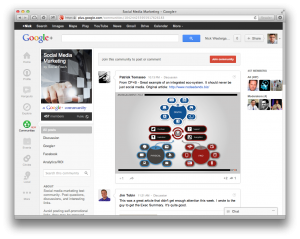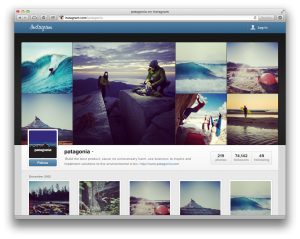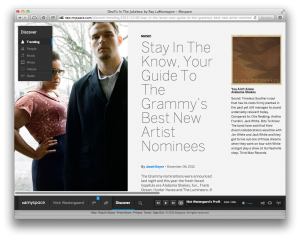Last week, Google announced that they were rolling out Google+ Communities, a feature very similar to Facebook’s popular groups. In thinking about the impact this has on brands, a bigger story is coming to light, and it’s not limited to Google. As the feud between Twitter and Instagram reignited recently, strategic pivots from both companies emerged. With so many changes on the horizon, brand builder need to keep an eye on several of these social network shifts in the year ahead.
At a glance, one could almost say that several of the major social networks are having an identity crisis – grasping for strategic edges and features from other platforms in an attempt to get ahead of the increasingly tough competition for users’ attention online. Let’s take a look at a few of these shifts and pivots among a few networks that you should keep track of in 2013.
Google+ Communities Take Aim at Facebook
 Boasting over 500 million users, Google+ adoption is on the rise. However, even as the network picks up steam with intuitive tools like hangouts, many still prefer Facebook because of their easy-to-use groups which fosters greater connectivity. Last week Google+ re-imagined groups as their new Google+ Communities (you can access this feature via the green icon with the three heads in the sidebar).
Boasting over 500 million users, Google+ adoption is on the rise. However, even as the network picks up steam with intuitive tools like hangouts, many still prefer Facebook because of their easy-to-use groups which fosters greater connectivity. Last week Google+ re-imagined groups as their new Google+ Communities (you can access this feature via the green icon with the three heads in the sidebar).
And really, that’s all they did. Like Facebook Groups, Google+ Communities can be either public or private (careful – once your community is public you can’t make it private) and most of the overall functionality is the same, though punctuated by Google+’s simple UI design. If one thing stands out it’s that communities seamlessly integrate with a couple of the network’s more sticky features — hangouts and their +1 button.
Does the Shift Matter? It’s pretty obvious that Google is trying to amp up its attack on Facebook with Google+ Communities. While Google+ reports impressive user growth, it still lacks the traction that groups provide for Facebook. Will it work? As conversations become more deeply entrenched through Google+ Communities, users will likely segue to other G+ features such as hangouts and chat, further enhancing Google’s play to be our online collaborative ecosystem. The biggest thing that stands in their way is that, for now, Facebook still has more people and they aren’t going anywhere.
Twitter as Instagram
 When Twitter lost out in their bid to purchase photo-sharing network Instagram relations got a little dicey between the two companies. Especially after social giant Facebook bought Instagram. For starters, Instagram users lost access to Twitter’s social graph which told them which of their Twitter followers was active on Instagram.
When Twitter lost out in their bid to purchase photo-sharing network Instagram relations got a little dicey between the two companies. Especially after social giant Facebook bought Instagram. For starters, Instagram users lost access to Twitter’s social graph which told them which of their Twitter followers was active on Instagram.
Recently, Instagram CEO Kevin Systrom announced that they’d no longer be allowing Twitter to expand Instagram posts in-stream on Twitter.com. Over the weekend, Mashable reported that Twitter is expected to roll-out photo filters of their own before the end of the year, putting them in direct competition with Instagram.
Does the Shift Matter? Neither network is going anywhere. Twitter has a proven track record, while Instagram has Facebook backing and its own rapidly growing user base — a new user joins Instagram every second. This will make things interesting, though, especially if Twitter’s filtered photos are larger (reports indicate they could be 1024 x 1024 vs. Instagram’s 612 x 612). In the end, can Twitter really become Instagram as it seems it’s trying to?
Instagram as a Web Property
 Last month, Instagram also turned a few heads by running counter to their own brand DNA, which is deeply rooted in being a mobile experience, and launched web-based profiles. The web rollout is limited to just profiles, lacking the ability to see the photos of those you follow on a homepage feed (there’s not even a tool for searching).
Last month, Instagram also turned a few heads by running counter to their own brand DNA, which is deeply rooted in being a mobile experience, and launched web-based profiles. The web rollout is limited to just profiles, lacking the ability to see the photos of those you follow on a homepage feed (there’s not even a tool for searching).
Does the Shift Matter? As profiles only, not a ton. But if you consider the previous shift and the fact that Twitter sees Instagram’s role as a content creator as poachable, it’s not hard to imagine Instagram building out their own web-based property in an attempt to be a more visually based micro-blogging hub with more robust community interaction features such as sharing someone else’s photo with your followers (Instagram’s answer to a retweet).
As always, Instagram needs to be careful as their brand has been built around simplicity. Adding expanded features on a web-based portal could enrage loyal fans if it distracts from their core features.
MySpace Is Back
 I never expected to be saying that … Yes, MySpace is back. Or New MySpace should I say. What was once the most-visited social site in the world has had new life breathed back into it after being acquired by Specifc Media and Justin Timberlake. Since then, they’ve completely overhauled the network, which was once a favorite of youth, musicians, and artists.
I never expected to be saying that … Yes, MySpace is back. Or New MySpace should I say. What was once the most-visited social site in the world has had new life breathed back into it after being acquired by Specifc Media and Justin Timberlake. Since then, they’ve completely overhauled the network, which was once a favorite of youth, musicians, and artists.
Right now New MySpace is invite-only. As I was able to snag an invite (I have a couple more if you contact me) I can tell you that what I saw surprised me. I expected a more grown-up version of MySpace. Something that shed their excessive customization and loud wallpapers for a platform that looked more like Facebook or Google+. Instead, the new MySpace features a visually patch-worked homepage where you can slide left to right to view more content. Profile features allow for a huge ‘cover’ and customized music.
Does This Shift Matter? One could argue that MySpace couldn’t be worse than the social purgatory they’ve been confined to for the past few years. With a savvy entertainment entrepreneur like Timberlake behind the scenes, continued focus on musicians and artists, and a visual style that’s as much a nod to Pinterest and Spotify as Facebook, they’re definitely a platform to watch in the new year. Especially for entertainment brands.
What Do You Think of These Social Network Shifts?
Can a once-great social network come back from the dead? Can one network become another by adopting their features? Can a simple mobile-only app transition to being a full-fledged web-based force? These are the questions we need to ask as we look ahed to a New Year of building our brands on these channels.
What social shifts do you think we need to watch in the year ahead?

